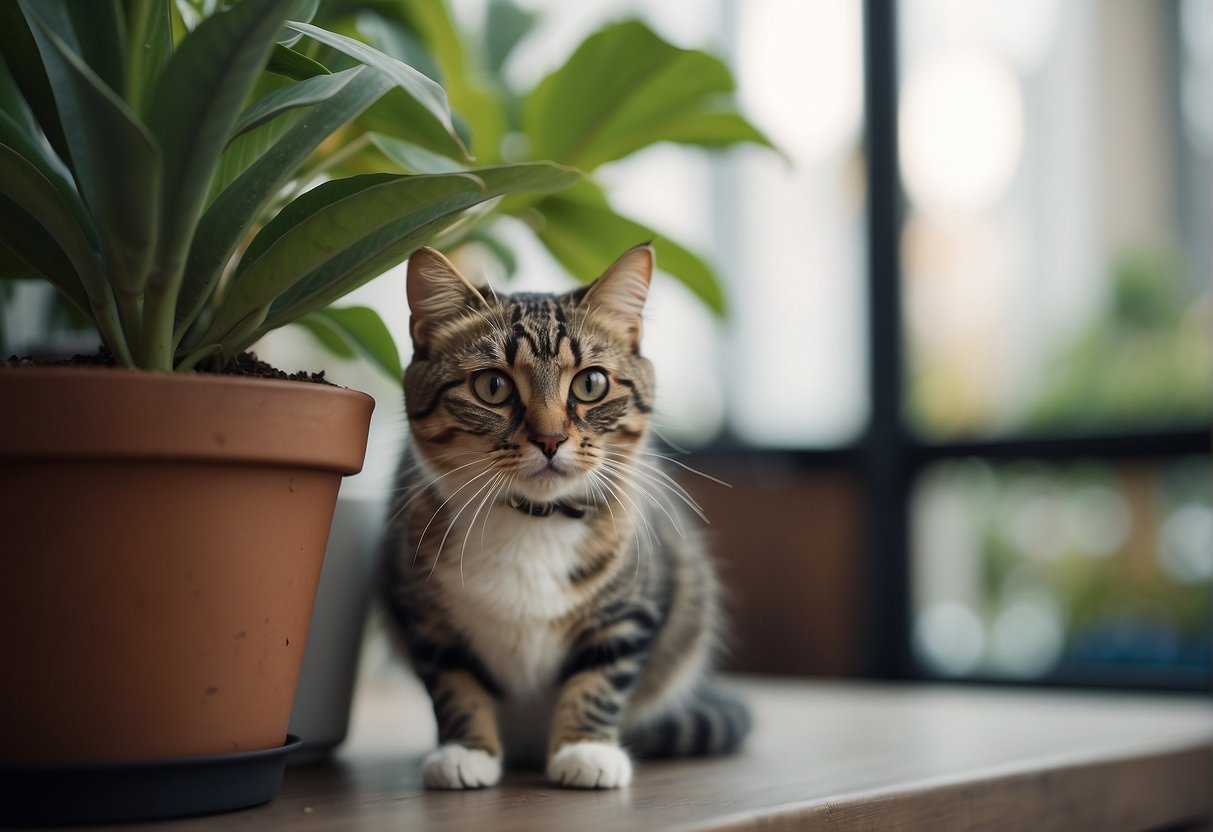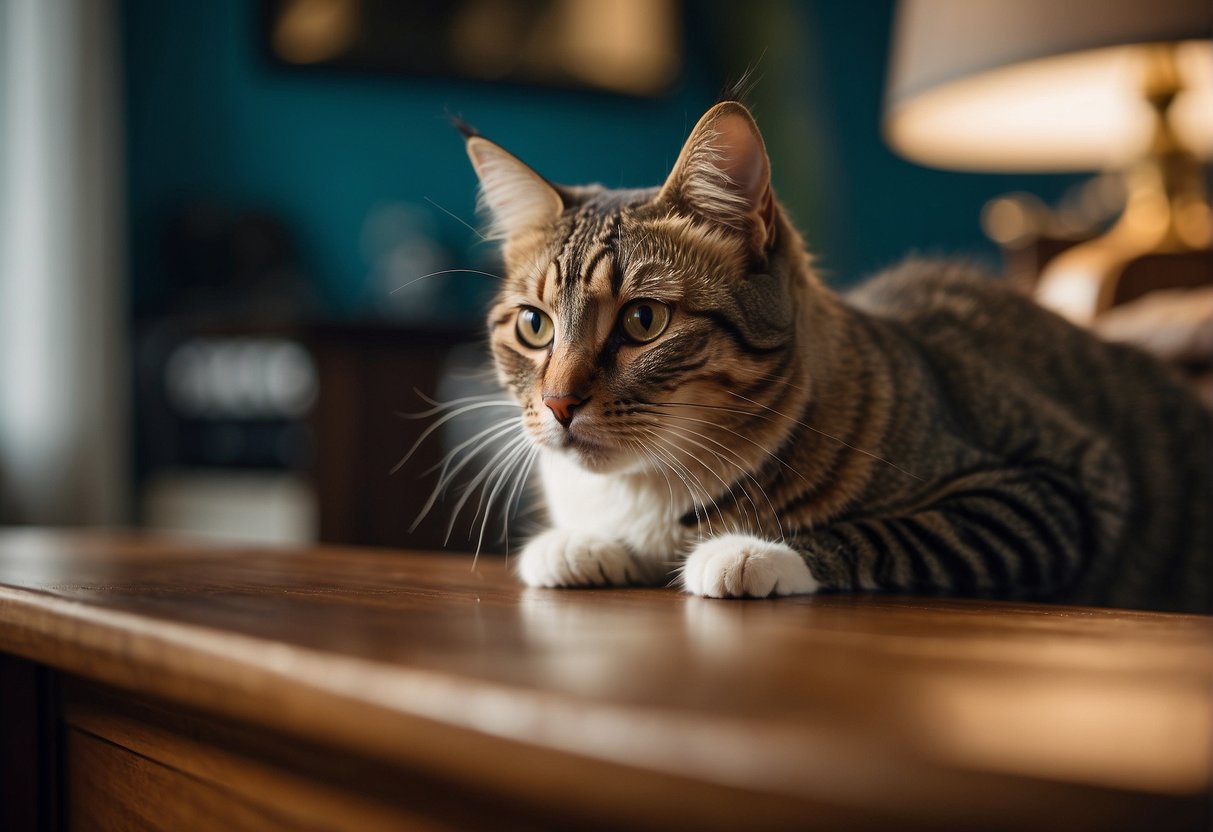Cats often sneak attack as part of their natural hunting instincts. When you find your cat crouched down with dilated pupils, tail twitching, and then suddenly springing forward, that’s them practicing their predatory skills.
In my own experience, playing with a simple string or feather toy can quickly turn into an ambush as your cat mimics the behaviors it would use in the wild to catch a meal.

This behavior isn’t just for outdoor adventurers; even indoor cats retain these fundamental needs to stalk and pounce.
It may come as a surprise during a quiet moment when your cat suddenly attacks your moving feet under the blankets. This is not just play; to your cat, the subtle movements resemble the actions of hidden prey.
Instinct Plays a Role In Cat Attacks

Navigating the intriguing world of felines, you’ll find that their behaviors, from cuddle sessions to sneak attacks, are deeply rooted in their natural instincts and social constructs.
Instinctual Behaviors
Cats are natural hunters, and even when they’re not hungry, their instincts drive them to stalk and pounce. This behavior can often translate into a sneak attack, typically characterized by a low crouch, followed by a swift leap towards their target.
When your cat is seemingly lounging, they’re often alert and ready to engage in play that mimics their predatory habits.
- Hunting: Even in a domestic setting, cats will exhibit hunting behaviors, including sneak attacks, which mirror their wild ancestors’ habits.
- Playing: Kittens learn from an early age to sneak attack during play, honing their skills for adulthood.
Socialization and Territory
Your cat’s interaction with you and other pets can give you insights into their social and territorial inclinations.
- Social Hierarchies: In multi-cat households, observe who initiates and who receives sneak attacks. This can reflect their social standing and territory within your home.
- Signaling Discomfort: If a sneak attack occurs seemingly unprovoked, it might signal that your cat’s territory feels threatened, or they’re not adequately socialized to distinguish between threats and friends.
Common Triggers for Cat Attacks
Understanding the reasons behind your cat’s seemingly unprovoked attacks can be crucial in preventing them. Identifying the trigger often leads to effective solutions, ensuring harmony in your home.
Pain and Medical Conditions
Pain or underlying medical conditions often result in a cat reacting with aggression. For example, if your usually placid cat starts to react with a surprising nip or swipe during petting, it may be a signal that a trip to the veterinarian is necessary.
Similarly, cats suffering from arthritis might attack if touched in a painful area.
Redirected and Fear Aggression
Cats sometimes exhibit redirected aggression when they perceive a threat. This occurs when they cannot reach the actual source of their agitation and turn their pent-up frustration toward someone or something else, which may even be their beloved owner.
Fear aggression is another common trigger; cats may strike out if something startles or scares them, such as a loud noise or a sudden movement.
Overstimulation and Petting-Induced Aggression
Even in the midst of a calm petting session, cats can experience overstimulation. This could lead to what’s known as petting-induced aggression, where the constant touch becomes too much for them, resulting in a bite or scratch.
Pay attention to your cat’s body language, such as twitching tails or rotating ears, to help you stop petting before they feel the need to lash out.
Identifying and Responding to Aggression
When your feline friend starts sneaking up and pouncing unexpectedly, it can be both startling and concerning.
Recognizing Aggressive Cues
Cats communicate a lot through their body language. Recognizing the cues is vital.
Defensive postures include flattened ears, dilated pupils, or a tucked tail, indicating your cat feels threatened.
Meanwhile, offensive postures might involve a stiffened body, direct staring, or even an arched back. These signs can precede a sneak attack and serve as warnings.
- Defensive Cues: Tucked tail, flattened ears, etc.
- Offensive Cues: Stiffened body, direct stare, etc.
Professional Assessment and Treatment
If you notice persistent aggression, it’s time to consult a professional. A veterinary behaviorist is an expert who can provide a diagnosis and tailor treatment options, such as medications or behavior modification techniques.
They can discern if the aggression stems from pain, fear, or behavioral issues, ensuring your cat gets the appropriate help.
- Consult a Veterinary Behaviorist
- Obtain a precise Diagnosis
- Follow a tailored Treatment plan
Environmental Enrichment
A stimulating environment can alleviate many stress-related behaviors in cats.
This includes providing climbing structures, hiding spots, and interactive toys that cater to their natural instincts to stalk and pounce. Keep their environment rich and engaging to reduce the likelihood of inappropriate aggression.
Behavioral Training and Positive Reinforcement
Train your cat using positive reinforcement. This involves rewarding good behavior with treats or affection.
Never punish aggression as this can enhance fear and anxiety.
Remember, consistency and patience are key. Reinforce the behaviors you want to see and ignore or redirect the undesirable ones.
- Reward good behavior with treats/affection
- Be patient and consistent

My name is James, and welcome to FAQCats!
Along with our team of cat owners, expert pet enthusiasts, and pet professionals, we aim to write engaging helpful, engaging content about cats. At FAQCats we strive to provide content that’s accurate and fun to read. Our team writes about everything related to cats; even the most complex of topics. Through extensive research and caring for our own fur-pals, we’re able to provide something cat owners worldwide will love. Have a look around, and leave us feedback anytime!

